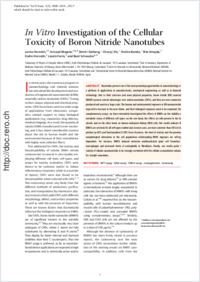In vitro investigation of the cellular toxicity of boron nitride nanotubes
- Horváth, Lenke Laboratory of Physics of Complex Matter (LPMC), Ecole Polytechnique Federale de Lausanne, Switzerland - Unit of Anatomy, Department of Medicine, University of Fribourg, Switzerland
- Magrez, Arnaud Laboratory of Physics of Complex Matter (LPMC), Ecole Polytechnique Federale de Lausanne, Switzerland - Center for Research on Electronically Advanced Materials (CREAM), Ecole Polytechnique Federale de Lausanne, Switzerland
- Golberg, Dmitri International Center for Materials Nanoarchitectonics (MANA), National Institute for Materials Science (NIMS), Namiki 1-1, Tsukuba, Ibaraki 3050044, Japan
- Zhi, Chunyi International Center for Materials Nanoarchitectonics (MANA), National Institute for Materials Science (NIMS), Namiki 1-1, Tsukuba, Ibaraki 3050044, Japan
- Bando, Yoshio International Center for Materials Nanoarchitectonics (MANA), National Institute for Materials Science (NIMS), Namiki 1-1, Tsukuba, Ibaraki 3050044, Japan
- Smajda, Rita Laboratory of Physics of Complex Matter (LPMC), Ecole Polytechnique Federale de Lausanne, Switzerland
- Horváth, Endre Laboratory of Physics of Complex Matter (LPMC), Ecole Polytechnique Federale de Lausanne, Switzerland
- Forró, László Laboratory of Physics of Complex Matter (LPMC), Ecole Polytechnique Federale de Lausanne, Switzerland
- Schwaller, Beat Unit of Anatomy, Department of Medicine, University of Fribourg, Switzerland
-
15.04.2011
Published in:
- ACS Nano. - 2011, vol. 5, no. 5, p. 3800–3810
English
Nanotubes present one of the most promising opportunities in nanotechnology with a plethora of applications in nanoelectronics, mechanical engineering, as well as in biomedical technology. Due to their structure and some physical properties, boron nitride (BN) nanotubes (BNNTs) possess several advantages over carbon nanotubes (CNTs), and they are now commercially produced and used on a large scale. The human and environmental exposure to BN nanomaterials is expected to increase in the near future, and their biological responses need to be examined. Using complementary assays, we have extensively investigated the effects of BNNTs on the viability and metabolic status of different cell types: on the one hand, the effects on cells present in the lung alveoli, and on the other hand, on human embryonic kidney (HEK) cells. Our results indicate that BNNTs are cytotoxic for all cell types studied and, in most cases, are more cytotoxic than CNTs in their pristine (p-CNT) and functionalized (f-CNT) form. However, the level of toxicity and the prominent morphological alterations in the cell populations withstanding BNNT exposure are cell-type-dependent. For instance, BNNTs induced extensive multinucleated giant cell formation in macrophages and increased levels of eosinophilia in fibroblasts. Finally, our results point the toxicity of tubular nanomaterials to be strongly correlated with the cellular accumulation enhanced for straight nanotubes.
- Faculty
- Faculté des sciences et de médecine
- Department
- Département de Médecine
- Language
-
- English
- Classification
- Biological sciences
- License
-
License undefined
- Identifiers
-
- RERO DOC 27216
- DOI 10.1021/nn200139h
- Persistent URL
- https://folia.unifr.ch/unifr/documents/301928
Other files
Statistics
Document views: 150
File downloads:
- pdf: 324
- Supplementary material: 149

